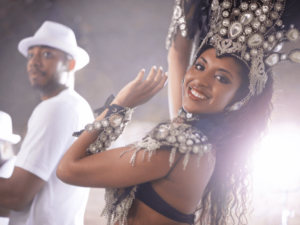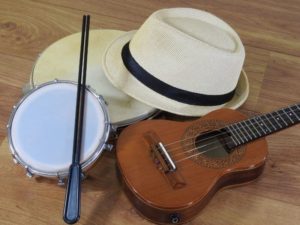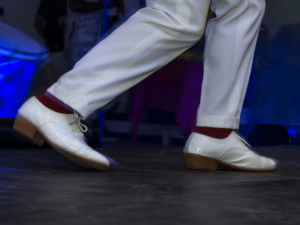Do you know Samba?
First, Samba is a music genre that emerged in Brazil at the beginning of the 20th century. The rhythm is recognized nationally and internationally as one of the strongest symbols of Brazil. Furthermore, this Afro-Brazilian cultural expression is considered Brazilian intangible cultural heritage. It emerged in Afro-Brazilian communities in some neighborhoods in Rio de Janeiro at the beginning of the 20th century.
Second, Samba is both an ethnography music rhythm and dance. It can be a solo, couple, or group dance. It is diffused throughout Brazil with choreographic and instrumental variations. In some urban areas, like in Rio, whenever there’s an informal live samba music performance, we call it: Roda de Samba
The tambourine is one of the most important instruments in the composition of a samba. Both musical genre and dance, are very traditional elements of Brazilian popular culture. Moreover, Samba is traditionally related to the Brazilian Carnival, especially with the samba school parades, which take place mainly in São Paulo and Rio de Janeiro.

How did the samba come about?
As it was said before, Samba emerged at the beginning of the 20th century and is an influence of African culture in Brazil. Samba has a connection with the dance circles that enslaved black people performed in their few free moments.
Likewise, these dance wheels, generally, were pulled by a musical rhythm obtained through the drums. One of the most practiced dances before samba was lundu, which, it is believed, was introduced in Brazil by Africans brought in a Diáspora from Angola.
In addition, one of the variants of these dance circles was the Samba de Roda, a musical style that brought together enslaved Africans to practice dance and capoeira. Indeed, this musical style emerged in Bahia, in the mid-19th century, and was one of the forerunners of traditional samba (known as urban samba from Rio de Janeiro). Samba de Roda is also directly linked to the ritual practices of the worship of the orixás.
In essence, the practices of Samba de Roda were brought to Rio de Janeiro at the end of the 19th century and the beginning of the 20th century. The abolition of slave labor, announced in 1888, enabled thousands of Africans and their enslaved descendants to conquer their “freedom”. The new condition and the lack of prospects made many of them move to the capital of Brazil: The city of Rio de Janeiro.

December 2nd – National Day of Samba!
At the beginning of the 20th century, Rio de Janeiro had a large black population. In this city, many of the Afro-Brazilians freed gathered in neighborhoods such as Saúde, Gamboa, Cidade Nova, and Estácio. In these places, the figure of Bahian aunts became extremely important to black communities. We talk about this issue in our Community Base Tour.
Further, the popularization of samba started in the 1930s. Before that, the genre was seen with a lot of prejudice by Brazilian society: Samba was considered a black and poor activity.
After it became popular, other subgenres emerged, such as samba-canção, samba-enredo, bossa nova, pagode, samba-de-breque, among others.
The importance of samba in Brazilian culture is such that, in addition to being part of Brazilian culture and identity, it is recognized as an intangible cultural heritage of Brazil.
Coupled with this, there is a commemorative date that was created in the 1960s and it became very popular: The National Day of Samba – December 2nd.
Overall, samba composition uses mainly percussion instruments, such as the tambourine, surdo, ganzá, and agogô; String instruments, such as the cavaquinho and the guitar;
And, the cuíca, an instrument from which sound is obtained by the friction of a rod.

Source: https://mundoeducacao.uol.com.br/carnaval/samba-produto-morro.htm




Well I truly enjoyed studying it. This subject procured by you is very helpful for proper planning.
We are very glad you’d like it! It will be more issues about brazilian culture very soon!
I would like to thank you for the efforts you have put in writing this website. Im hoping to view the same high-grade blog posts by you later on as well. In fact, your creative writing abilities has encouraged me to get my own, personal site now 😉